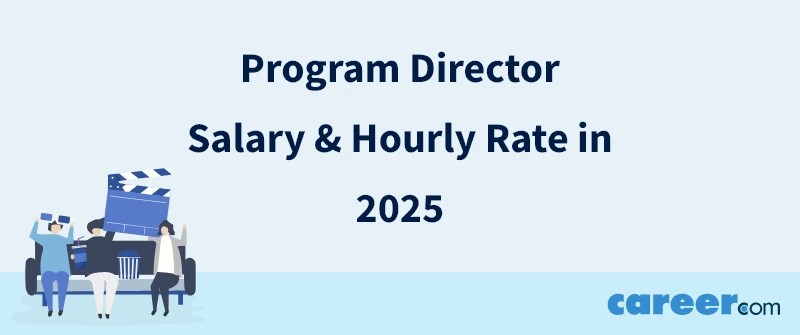Program Director Salary & Hourly Rate in 2025

The role of a program director in the nonprofit sector is essential for overseeing programs, managing teams, and ensuring that initiatives align with organizational goals and community needs. Program Directors coordinate operations, budgets, and staff to deliver impactful outcomes.
As the nonprofit sector grows and demand for social impact increases, the need for skilled program directors continues to rise. This article will explore the program director salary, factors influencing earnings, and how pay varies across industries and state.
An Overview of Salaries Program Director
As of August 15, 2025, the average salary for a program director in the United States is $121,850 per year. Compensation typically ranges from $90,309 to $148,367, depending on organization size, experience, and location.
| Percentile | Average Annual Salary |
|---|---|
| 10% Percentile | $90,309 |
| 25% Percentile | $105,340 |
| 50% Percentile (Median) | $121,850 |
| 75% Percentile | $135,730 |
| 90% Percentile | $148,367 |
Program Director Salary: Hourly, Weekly, Monthly, and Yearly Breakdown
The average salary for a program director can be broken down into hourly, weekly, monthly, and yearly amounts. According to Salary.com, the average rate for a program director (non-profit) in the United States is approximately $59 per hour or $121,850 per month.
- Average salary per hour: $59
- Average salary per week: $2,343
- Average salary per month: $10,154
- Average salary per year: $121,850
The average hourly rate is particularly useful for interim or consulting program directors who bill by the hour. Organizations that offer additional compensation such as performance bonuses, grants, and enhanced benefits can further increase total annual earnings.
How Experience Impacts Program Director Salary
Experience is a major factor in how much a program director can earn. Entry-level positions start closer to the lower end of the range, while seasoned professionals overseeing large budgets and staff teams can earn near the top percentile.
Based on Salary.com data, here’s how compensation typically grows with experience:
- Entry Level Program Director (Non-Profit): $115,690
- Intermediate Level Program Director (Non-Profit): $116,429
- Senior Level Program Director (Non-Profit): $118,154
- Specialist Level Program Director (Non-Profit): $120,125
- Expert Level Program Director (Non-Profit): $123,300
State-by-State Breakdown of Average Salaries for Program Director
Each U.S. state offers different average salaries for program directors, influenced by factors like regional demand, cost of living, and the presence of nonprofit activities. According to Salary.com data, District of Columbia offers the highest average annual salary for Program Directors at $134,910, followed by California and Massachusetts, which average around $134,400 and $132,610, respectively.
Here’s a breakdown based on available state and city-level data:
| State | Average Salary |
|---|---|
| Alaska | $131,900 |
| Alabama | $111,950 |
| Arkansas | $110,080 |
| Arizona | $118,730 |
| California | $134,400 |
| Colorado | $124,330 |
| Connecticut | $130,220 |
| District of Columbia | $134,910 |
| Delaware | $123,400 |
| Florida | $115,300 |
| Georgia | $117,530 |
| Hawaii | $127,360 |
| Iowa | $116,610 |
| Idaho | $113,750 |
| Illinois | $124,200 |
| Indiana | $116,970 |
| Kansas | $116,030 |
| Kentucky | $114,660 |
| Louisiana | $115,860 |
| Massachusetts | $132,610 |
| Maryland | $125,640 |
| Maine | $118,810 |
| Michigan | $120,000 |
| Minnesota | $124,690 |
| Missouri | $115,770 |
| Mississippi | $108,670 |
| Montana | $115,040 |
| North Carolina | $115,800 |
| North Dakota | $120,370 |
| Nebraska | $114,800 |
| New Hampshire | $123,190 |
| New Jersey | $132,070 |
| New Mexico | $112,860 |
| Nevada | $120,600 |
| New York | $129,540 |
| Ohio | $118,650 |
| Oklahoma | $112,660 |
| Oregon | $123,740 |
| Pennsylvania | $121,300 |
| Rhode Island | $126,340 |
| South Carolina | $114,180 |
| South Dakota | $110,740 |
| Tennessee | $113,870 |
| Texas | $118,850 |
| Utah | $116,690 |
| Virginia | $122,700 |
| Vermont | $119,600 |
| Washington | $132,120 |
| Wisconsin | $119,870 |
| West Virginia | $109,730 |
| Wyoming | $116,860 |
Program Director: Top Earning Cities Revealed
The top-paying locations for program directors are typically urban centers with strong nonprofit sectors, robust funding ecosystems, or high-paying leadership roles. These areas offer premium compensation and often better access to significant program portfolios and executive-level opportunities.
| City & State | Average Salary |
|---|---|
| San Jose, CA | $153,690 |
| San Francisco, CA | $152,180 |
| Oakland, CA | $148,800 |
| New York, NY | $141,210 |
| Queens Village, NY | $140,300 |
| Paramus, NJ | $139,320 |
These locations not only pay more, but they also present greater opportunities for career advancement, including leadership roles like Director of Program Management, which command substantially higher salaries.
Explore Program Director Benefits and Perks Beyond Salary
In addition to their base salary, program directors in the nonprofit sector typically receive a range of benefits that improve their total compensation package. According to Salary.com, common offerings include:
- Social Security
- Healthcare
- 401(k) or 403(b)
- Pension
- Disability insurance
- Paid time off
Program Director Job Description: Roles and Responsibilities
A program director is primarily responsible for orchestrating, overseeing, and enhancing programs that align with an organization's mission, typically within the nonprofit space or mission-driven sectors. Their work is vital in ensuring that programs are executed effectively, stakeholders are aligned, and outcomes are delivered.
The job description of a program director includes:
- Designing and implementing programs that address organizational goals and community needs.
- Coordinating staff, volunteers, and external partners to ensure smooth program execution.
- Overseeing testing, evaluation, and reporting, including performance metrics and impact assessments.
- Collaborating with funders, boards, and leadership teams to align programs with strategic objectives.
- Ensuring compliance with organizational, regulatory, and grant-related requirements.
Program directors must stay current with best practices in program development, nonprofit leadership, and sector-specific trends. They often require strong skills in management, strategic planning, budget allocation, stakeholder engagement, and outcome measurement.
When and How to Ask for a Raise as a Program Director?
If you’re aiming to boost your program director salary, it’s important to understand what factors influence how much a program director can earn each year. In today’s competitive job market, companies are offering some of the highest salaries to program directors who can coordinate cross-department activities, ensure smooth operations, and deliver measurable results.
Here are practical steps to help you earn more and position yourself for one of the best-paying jobs in your field:
- Expand your leadership skills: Employers value employees who can serve as both visionary leaders and skilled project managers. By gaining certifications like PMP or Lean Six Sigma, you increase your value and open doors to new jobs with higher pay.
- Show measurable impact: Keep a detailed record of your achievements such as reducing costs, improving workflows, or meeting tight deadlines. These results make a strong case for moving from an average salary to the highest pay ranges.
- Research market salaries: Use job postings, industry reports, and salary databases to find the current average and highest salaries for program directors in your region. This data ensures you negotiate based on facts, not guesses.
- Time your request strategically: Most companies review compensation once a year, often during annual performance evaluations. Requesting a raise at the right time especially after a major success, greatly increases your chances.
- Negotiate the full package: If a salary increase isn’t possible immediately, negotiate for perks like bonuses, PTO, or remote work options. Over time, these benefits can significantly add to your overall earnings.
Why Do Program Director Make So Much?
Program directors earn competitive salaries because their role is central to an organization’s success, requiring them to oversee multiple projects, manage employees, and ensure that all activities align with strategic goals. As industries such as healthcare, technology, education, and finance expand, the demand for experienced program directors continues to grow, driving salaries higher.
Scope management provides one of the strongest salary boosts, with a 10.67% increase, while program management follows closely behind at 8.90%. Professionals skilled in project communications and stakeholder management each see an 8.12% increase, while expertise in project cost management and project risk management delivers an 8.01% boost. Schedule management offers a 7.75% increase, and those proficient in procurement benefit from a 7.21% increase in salary.
- Project Communications: +8.12% salary increase
- Scope Management: +10.67% salary increase
- Schedule Management: +7.75% salary increase
- Project Cost Management: +8.01% salary increase
- Project Risk Management: +8.01% salary increase
- Stakeholder Management: +8.12% salary increase
- Program Management: +8.90% salary increase
- Procurement: +7.21% salary increase
The Future of Program Director: Job Outlook and Career Trends
Looking ahead, the demand for program directors is projected to remain strong and grow steadily through 2033. The U.S. Bureau of Labor Statistics (BLS) anticipates continued employment growth for management occupations, a category that includes program directors. Several trends are fueling this positive outlook:
- Digital Transformation: As organizations adopt new technologies and shift toward data-driven decision-making, skilled program directors will be needed to coordinate complex initiatives and ensure smooth implementation.
- Cross-Industry Expansion: From healthcare to finance, industries are launching more multi-department programs, increasing the need for leaders who can oversee diverse teams and meet strategic goals.
- Global Project Coordination: With more companies operating internationally, program directors who can manage large-scale, cross-border projects will be in particularly high demand.



